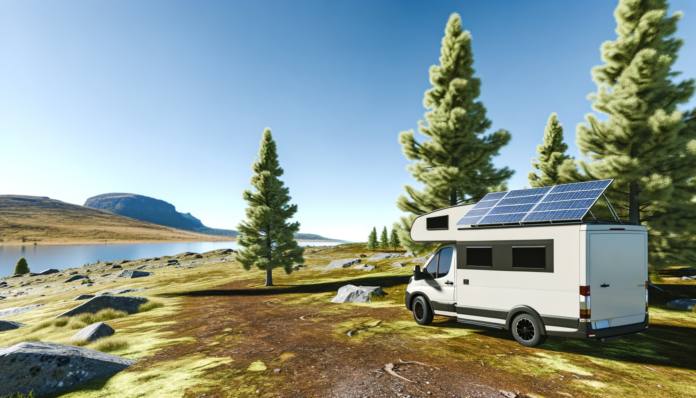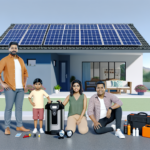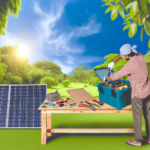Introduction to Solar Power for Adventurers
Why Solar Power is Ideal for Outdoor Enthusiasts
For adventurers who thrive on exploring the great outdoors, solar power offers an unparalleled solution for staying connected and powered up. Whether you’re navigating remote rivers, trekking through dense forests, or camping under the stars, solar panels provide a reliable and sustainable energy source. Devices like the Solar Adventurer, which includes a Lithium-Ion battery and USB output, are perfect for charging essential gear such as phones, GPS units, and headlamps. This ensures that you can safely navigate and share your stories from even the most isolated locations. The portability and ease of use make solar power an indispensable tool for any outdoor enthusiast.
The Environmental Benefits of Solar Energy
One of the most compelling reasons to adopt solar power is its positive impact on the environment. Unlike fossil fuels, solar energy is a clean and renewable resource. By harnessing the power of the sun, adventurers can significantly reduce their carbon footprint. This not only helps in preserving the natural beauty of the landscapes they explore but also contributes to the broader fight against climate change. Using solar panels means fewer batteries to dispose of and less reliance on non-renewable energy sources, making it a responsible choice for eco-conscious travelers.
Overview of Solar Technology
Understanding the basics of solar technology can help adventurers make informed decisions about their energy needs. Solar panels work by converting sunlight into electricity through photovoltaic cells. These cells are typically made from silicon and are designed to capture and convert solar energy efficiently. Modern solar panels come in various types, including monocrystalline, polycrystalline, and thin-film, each with its own set of advantages and efficiency levels.
Key components of a solar power system include the solar panels themselves, a charge controller to regulate the energy flow, and batteries to store the generated power. Advanced systems may also include inverters to convert the stored DC power into AC power, which is compatible with most electronic devices. With innovations in solar panel design and battery storage, adventurers now have access to more efficient and portable solar solutions than ever before.
In summary, solar power is an ideal choice for outdoor enthusiasts due to its reliability, environmental benefits, and the advancements in solar technology. By incorporating solar panels into their gear, adventurers can ensure they have a sustainable and dependable energy source for all their journeys.
How Solar Panels Work
The Science Behind Solar Panels
Solar panels, also known as photovoltaic (PV) panels, convert sunlight into electricity through a process called the photovoltaic effect. When sunlight hits the solar cells within the panel, it excites electrons in the cell’s semiconductor material, typically silicon. This excitement causes the electrons to flow, creating an electric current. This direct current (DC) electricity is then captured by the wiring in the solar panel and can be used to power devices or stored in batteries for later use.
Types of Solar Panels
There are several types of solar panels available, each with its own advantages and disadvantages:
- Monocrystalline Solar Panels: Made from a single continuous crystal structure, these panels are known for their high efficiency and longevity. They are typically more expensive but offer better performance in low-light conditions.
- Polycrystalline Solar Panels: These panels are made from multiple silicon crystals and are generally less efficient than monocrystalline panels. However, they are more affordable and still provide a good balance of efficiency and cost.
- Thin-Film Solar Panels: Made by depositing one or more layers of photovoltaic material onto a substrate, these panels are lightweight and flexible. They are less efficient than crystalline panels but can be used in a variety of applications where flexibility and weight are important factors.
Key Components of a Solar Power System
A complete solar power system consists of several key components that work together to capture, convert, and store solar energy:
- Solar Panels: The primary component that captures sunlight and converts it into DC electricity.
- Charge Controller: This device regulates the voltage and current coming from the solar panels to the batteries, preventing overcharging and ensuring efficient energy storage.
- Battery Bank: Batteries store the electricity generated by the solar panels for use when sunlight is not available. Common types include lead-acid, AGM, and lithium-ion batteries.
- Inverter: Since most household and electronic devices run on alternating current (AC), an inverter is needed to convert the DC electricity stored in the batteries into AC electricity.
- Wiring and Connectors: High-quality cables and connectors are essential for minimizing energy loss and ensuring the safe and efficient transfer of electricity between components.
Understanding how these components work together is crucial for setting up an efficient and reliable solar power system for your adventures. By harnessing the power of the sun, you can enjoy energy independence and reduce your environmental footprint while exploring the great outdoors.
Choosing the Right Solar Panels for Your Adventures
Factors to Consider: Size, Weight, and Efficiency
When selecting solar panels for your adventures, it’s crucial to balance size, weight, and efficiency. **Size** determines how much surface area the panels will cover, which directly impacts the amount of sunlight they can capture. Larger panels generally produce more power but can be cumbersome to transport and install. **Weight** is another critical factor, especially for backpackers and hikers who need lightweight gear. Heavier panels might offer more durability and power but can be impractical for mobile use. **Efficiency** refers to how well the panels convert sunlight into electricity. High-efficiency panels are ideal for limited space scenarios, as they generate more power per square foot. However, they often come at a higher cost.
Portable vs. Fixed Solar Panels
Choosing between portable and fixed solar panels depends on your specific needs and adventure style. **Portable solar panels** are designed for flexibility and ease of transport. They are perfect for short trips, hiking, and camping, where you need a lightweight and compact power source. These panels can be set up and taken down quickly, making them ideal for adventurers on the move. On the other hand, **fixed solar panels** are mounted permanently, often on the roof of an RV or a van. They are suitable for long-term use and provide a stable power source for extended trips. Fixed panels are generally more robust and can capture more sunlight due to their larger size and optimal placement.
Understanding Wattage and Power Needs
Understanding your wattage and power needs is essential for choosing the right solar panels. Start by calculating your daily energy consumption. List all the devices you plan to power, such as lights, fans, refrigerators, and electronic gadgets. Each device should have a power rating in watts (W) or kilowatt-hours (kWh). Multiply the wattage by the number of hours you use each device daily to get the total energy consumption in watt-hours (Wh). For example, if your LED lights use 50 watts and run for 4 hours a day, they consume 200 Wh daily.
Once you know your total daily energy consumption, you can determine the number of solar panels needed. Solar panels are rated by their wattage output under standard conditions. Divide your daily energy usage by the wattage output of a single panel to estimate how many panels you’ll need. Consider factors like panel efficiency and sunlight availability. Higher efficiency panels produce more power per square foot, which is beneficial in limited space scenarios. Additionally, assess your typical camping locations: more sunlight exposure means fewer panels may be needed.
By carefully considering size, weight, efficiency, and your specific power needs, you can select the perfect solar panels to power your adventures, ensuring a reliable and sustainable energy source wherever your journey takes you.
Setting Up Your Solar Power System
Step-by-Step Guide to Installation
Setting up a solar power system for your adventures can seem daunting, but with a clear step-by-step guide, it becomes manageable. Here’s how to get started:
1. **Assess Your Power Needs**: Calculate your daily energy consumption by listing all the devices you plan to power and their wattage. This will help you determine the number and size of solar panels required.
2. **Choose Your Components**: Select solar panels, a charge controller, batteries, and an inverter. Ensure they are compatible and meet your energy needs.
3. **Mount the Solar Panels**: Install the panels on a flat, unobstructed surface, typically the roof of your RV or a portable stand. Use mounting brackets and hardware to secure them in place.
4. **Route the Cables**: Connect the solar panels to the charge controller using appropriate cables. Ensure the connections are secure and weatherproof.
5. **Install the Charge Controller**: Mount the charge controller close to the batteries to minimize voltage drop. Connect the controller to the batteries, ensuring the correct polarity.
6. **Connect the Inverter**: Install the inverter near the batteries and connect it to convert DC power to AC power for your appliances.
7. **Test the System**: Once everything is connected, test the system to ensure it’s working correctly. Monitor the charge controller’s display to check the power flow and battery status.
Tips for Optimal Placement and Angle
The efficiency of your solar panels greatly depends on their placement and angle. Here are some tips to maximize their performance:
– **Optimal Angle**: Position your panels at an angle equal to your latitude for year-round use. Adjust the angle seasonally if possible—steeper in winter and flatter in summer.
– **Avoid Shading**: Ensure the panels are free from shadows cast by trees, buildings, or other obstructions. Even partial shading can significantly reduce efficiency.
– **Orientation**: In the Northern Hemisphere, face the panels south to capture the most sunlight. In the Southern Hemisphere, face them north.
– **Portable Panels**: If using portable panels, move them throughout the day to follow the sun’s path, maximizing exposure.
Connecting to Batteries and Devices
Properly connecting your solar panels to batteries and devices is crucial for a functional system. Here’s how to do it:
– **Battery Selection**: Choose deep-cycle batteries like AGM or lithium-ion, which are designed for repeated charging and discharging.
– **Wiring**: Use appropriate gauge wires to handle the current without significant voltage drop. Thicker wires are better for longer distances.
– **Charge Controller**: Connect the solar panels to the charge controller first, then connect the controller to the batteries. This prevents overcharging and optimizes battery life.
– **Inverter Connection**: Connect the inverter to the batteries to convert DC power to AC power. Ensure the inverter’s capacity matches your peak power needs.
– **Device Connection**: Plug your devices into the inverter or directly into the battery if they are DC-powered. Use a fuse or circuit breaker to protect against overcurrent.
By following these steps and tips, you can set up an efficient and reliable solar power system to enhance your outdoor adventures.
Maintaining and Troubleshooting Your Solar Panels
Routine Maintenance Tips
Maintaining your solar panels is crucial to ensure they operate at peak efficiency. Here are some routine maintenance tips to keep your system in top shape:
- Regular Cleaning: Dust, dirt, and debris can accumulate on the surface of your solar panels, reducing their efficiency. Clean the panels with a soft cloth and mild soap solution every few months or after a heavy storm.
- Inspect for Damage: Regularly check for any physical damage such as cracks, chips, or delamination. Addressing these issues promptly can prevent further deterioration.
- Monitor Performance: Use a monitoring system to keep track of your solar panel’s performance. This can help you identify any drops in efficiency early on.
- Check Connections: Ensure all electrical connections are secure and free from corrosion. Loose or corroded connections can lead to power loss.
Common Issues and How to Fix Them
Even with regular maintenance, you may encounter some common issues with your solar panels. Here’s how to troubleshoot and fix them:
- Under-Production of Power: If your panels are not producing as much power as expected, check for shading, dirt, or debris on the panels. Ensure they are oriented correctly and at the optimal angle. Testing the open-circuit voltage (Voc) and short-circuit current (Isc) with a multimeter can help diagnose the issue. Compare the results with the specifications sheet to determine if the panels are underperforming.
- Delamination: This occurs when the layers of the solar panel start to separate. Delamination can lead to moisture ingress and reduced efficiency. If you notice delamination, it’s best to consult a professional for repair or replacement.
- Snail Trails: These are discolored lines that appear on the panels and can indicate micro-cracks. While they may not immediately affect performance, they can lead to long-term efficiency loss. Regular inspection and professional assessment are recommended.
- Physical Damage: Cracks or chips in the panels can significantly impact their performance. Minor damage can sometimes be repaired with special adhesives, but severe damage usually requires panel replacement.
When to Seek Professional Help
While many maintenance tasks and minor troubleshooting can be handled by the user, certain situations warrant professional intervention:
- Severe Physical Damage: If your panels have extensive cracks, chips, or delamination, it’s best to consult a professional for repair or replacement.
- Electrical Issues: If you experience persistent electrical problems such as frequent tripping of the charge controller or inverter, a professional can diagnose and fix the issue safely.
- Performance Drops: If you notice a significant drop in performance that routine troubleshooting cannot resolve, a professional assessment can help identify underlying issues.
- Installation and Upgrades: For complex installations or system upgrades, professional expertise ensures that your system is set up correctly and safely.
By following these maintenance and troubleshooting tips, you can ensure that your solar panels continue to power your adventures efficiently and reliably.
Maximizing Efficiency and Performance
Seasonal Adjustments and Considerations
To ensure your solar panels operate at peak efficiency throughout the year, it’s essential to make seasonal adjustments. The angle of the sun changes with the seasons, affecting the amount of sunlight your panels receive. During summer, the sun is higher in the sky, so a flatter angle may be more effective. Conversely, in winter, the sun is lower, and a steeper angle can help capture more sunlight.
**Key Tips:**
– **Adjust Panel Tilt:** Modify the tilt of your panels to match the seasonal sun angle. This can significantly boost energy capture.
– **Clear Snow and Debris:** In winter, ensure snow and ice are cleared from the panels. In autumn, remove fallen leaves and other debris.
– **Monitor Shading:** As the sun’s path changes, so does the shading from nearby trees or structures. Regularly check and trim any overhanging branches.
Using Solar Trackers and Other Accessories
Solar trackers and other accessories can further enhance the efficiency of your solar power system. Trackers adjust the position of your panels to follow the sun’s movement across the sky, maximizing exposure and energy capture.
**Types of Solar Trackers:**
– **Single-Axis Trackers:** These adjust the panel’s angle along one axis, typically east to west, to follow the sun’s daily path.
– **Dual-Axis Trackers:** These adjust along two axes, both east-west and north-south, to follow the sun’s daily and seasonal movements.
**Other Useful Accessories:**
– **Solar Panel Cleaning Kits:** Regular cleaning ensures maximum sunlight absorption.
– **Energy Meters:** These devices help monitor energy production and consumption, allowing you to make informed adjustments.
– **Battery Management Systems (BMS):** These systems optimize battery performance and longevity by managing charge and discharge cycles.
Monitoring Your System’s Performance
Continuous monitoring of your solar power system is crucial for maintaining efficiency and identifying potential issues early. Modern solar systems often come with integrated monitoring tools that provide real-time data on energy production, battery status, and overall system health.
**Monitoring Tools:**
– **Charge Controllers with Display:** Many charge controllers feature built-in displays showing real-time data on voltage, current, and battery status.
– **Remote Monitoring Systems:** These systems allow you to track your solar setup’s performance from anywhere via a smartphone or computer.
– **Energy Management Software:** Advanced software solutions offer detailed analytics and historical data, helping you optimize energy usage and identify trends.
**Best Practices:**
– **Regularly Check Data:** Make it a habit to review your system’s performance data regularly. Look for any anomalies or drops in energy production.
– **Set Alerts:** Use monitoring tools that allow you to set alerts for specific conditions, such as low battery levels or reduced energy output.
– **Perform Routine Inspections:** Periodically inspect all components of your solar system, including panels, wiring, and batteries, to ensure everything is functioning correctly.
By making seasonal adjustments, utilizing solar trackers and accessories, and diligently monitoring your system’s performance, you can maximize the efficiency and longevity of your solar power setup. This proactive approach ensures that your adventures remain powered by clean, renewable energy, no matter where your journey takes you.
Future Trends in Solar Technology
Innovations in Solar Panel Design
The solar industry is continuously evolving, with significant advancements in solar panel design aimed at increasing efficiency and versatility. One of the most notable innovations is the development of bifacial solar panels, which can capture sunlight on both sides, thereby increasing energy output. Additionally, the integration of perovskite materials into solar cells is showing promise for higher efficiency rates and lower production costs. Flexible and lightweight solar panels are also gaining traction, making them ideal for portable applications and unconventional surfaces, such as tents and backpacks, which are perfect for adventurers.
Advancements in Battery Storage
Battery storage technology is crucial for maximizing the utility of solar power, especially for off-grid applications. Recent advancements in lithium-ion batteries have significantly improved their energy density, lifespan, and charging speed. Moreover, solid-state batteries are on the horizon, offering even greater energy storage capabilities and enhanced safety features. These innovations are particularly beneficial for adventurers who require reliable and long-lasting power sources for their journeys. Enhanced battery management systems (BMS) are also being developed to optimize the performance and longevity of battery packs, ensuring that stored solar energy is used efficiently.
The Role of Solar Power in Sustainable Living
Solar power is playing an increasingly vital role in promoting sustainable living. As the technology becomes more accessible and affordable, more individuals and communities are adopting solar solutions to reduce their carbon footprint. For adventurers, this means the ability to explore remote locations without relying on fossil fuels, thereby minimizing environmental impact. The integration of solar power with other renewable energy sources, such as wind and hydro, is also being explored to create hybrid systems that offer greater reliability and sustainability. Furthermore, the rise of smart grids and energy management systems allows for better monitoring and optimization of energy use, making sustainable living more practical and efficient.
In conclusion, the future of solar technology is bright, with continuous innovations in panel design, battery storage, and sustainable living practices. These advancements not only enhance the efficiency and reliability of solar power but also make it a more viable option for adventurers seeking eco-friendly energy solutions for their journeys.






